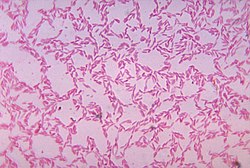| Bacteroidales | |
|---|---|
 | |
| Bacteroides biacutis anaerobically cultured in blood agar medium | |
| Scientific classification | |
| Domain: | Bacteria |
| Kingdom: | Pseudomonadati |
| Phylum: | Bacteroidota |
| Class: | Bacteroidia Krieg 2012 [1] |
| Order: | Bacteroidales Krieg 2012 [2] |
| Families [3] [4] [5] | |
| |
| Synonyms | |
| |
Bacteroidales is an order of bacteria. [2] [3] Notably it includes the genera Prevotella and Bacteroides , which are commonly found in the human gut microbiota.